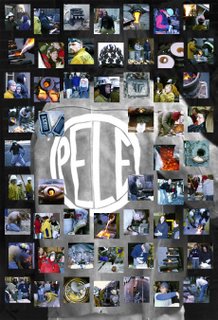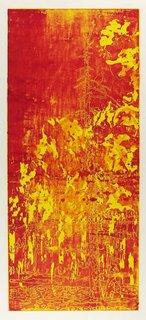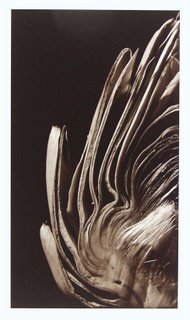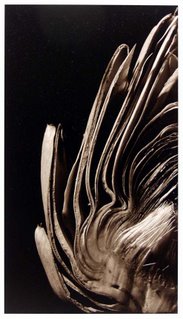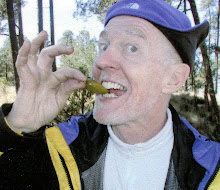

After "Standard Issue" (see next article) I meandered back up to the Grand Marais (MN) Art Colony for a workshop on Fusing and Slumping Glass. This a lot of fun, and I already have a project in mind for it. I finished off my summer workshop series with a trip to Peters Valley Craft Center in Layton, NJ. It is part of the Delaware Water Gap National Recreation Area, and so is very rural and pristine in character. It is actually an old abandoned village and the park supervisor wanted to preserve the buildings. So, he talked the craft center to move in and help take care of them. My studio was about a quarter mile down from the main crossroad in an old farm. We stayed in the farmhouse, and the studio was in one of the barns. So what medium did I take? Chasing and Repousse on Steel taught by
Kirsten Skiles from Desoto, WI. Strange I had to go all the way out to New Jersey in order to take a class from a home area artist. However, she also has some upcoming classes at Tunnel Mill near Rochester, MN. You can visit her blog to see some of the incredible artwork she produces. There are also some photos from the class there, and you can get an idea of the process. It is a cold forging process for moving metal. One works the metal sheet from both the front (chasing) and back (repousse) to produce a relief. One uses pitch in a pot as a supporting medium to help keep from punching holes through the metal.
Okay, so now we are getting around to the photos. One needs to have a pot to put their pitch in. Judith Berger of
Blue Moon Press, a truly multi-talented person and one of my classmates, suggested I find a used discing blade to make my pot. If you're from Wisconsin you will recognize that is one of those circular discs farmers pull in gangs over their fields to break up the soil. Using my scavenging skills, I rescued one from being melted down at the local metal recycling yard. I wire brushed it to clean it up, used by blacksmithing skills to heat it and put just a tad more volume to it, and finally welded in the hole in the bottom. There you have the fore and aft pictures. Beautiful, huh? Well, okay it's a tad squiggly. I had it pretty good, but when I welded it I think the heat warped it a tad. I'll have to go back and re-true it as best I can. I have ordered the pitch for it, and when it arrives I will start work with it.
What am I going to make? A friend, and Portland, OR poet Christopher Keller has commissioned me to make a piece for the front cover of his upcoming third publication. It is a love story between Horacio and La Maga. I won't go into the particulars, but will leave that for when the book is out. At this point I envision representing both characters with facial masks. Horacio will be made out of metal, and thus the need for the pitch pot. La Maga will be made out of glass with perhaps a print or text encased and then slumped into a mold. I'm very excited about working on these, and anxious to get going. I will be sure to add more articles on them as they progress.
 This semester I presented to myself some significant challenges. While still very much in love with the printed image, I found myself looking for new ways to present it. I decided to replace paper which is the typical support medium with glass. When doing so one has to ask why? What are the advantages of the new support medium verses the old? Glass has the qualities of illumination, molding, slumping, and breaking. This print (they're both the same) originally came off an intaglio plate onto a transfer paper which was then used to transfer the ink onto the glass. In this case a sheet of white glass was printed on and a sheet of clear glass placed over the top and fused. The print in the black shadow box was dropped to break it, and then reassembled in a broken manner with the various pieces at different height levels. The print is about Apartheid in South Africa and it's effect on those it brutally repressed. The broken piece symbolizes on Apartheid shattered the lives on those people.
This semester I presented to myself some significant challenges. While still very much in love with the printed image, I found myself looking for new ways to present it. I decided to replace paper which is the typical support medium with glass. When doing so one has to ask why? What are the advantages of the new support medium verses the old? Glass has the qualities of illumination, molding, slumping, and breaking. This print (they're both the same) originally came off an intaglio plate onto a transfer paper which was then used to transfer the ink onto the glass. In this case a sheet of white glass was printed on and a sheet of clear glass placed over the top and fused. The print in the black shadow box was dropped to break it, and then reassembled in a broken manner with the various pieces at different height levels. The print is about Apartheid in South Africa and it's effect on those it brutally repressed. The broken piece symbolizes on Apartheid shattered the lives on those people.

















